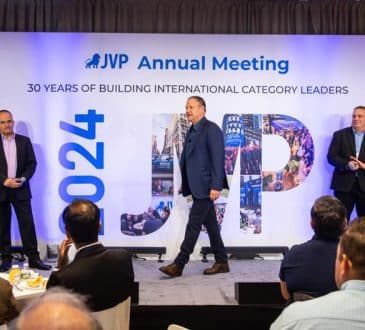Reframing Hybrid Work—A Necessary Foundation for Competitive Advantage

The Digital Genie is out of the bottle, causing all kinds of multidimensional change! New work models are disruptive—but necessary—adaptations for organizations to be adequately responsive. Offering new options is both an unavoidable consequence of our new circumstances and critical for your business to adopt and for employees to keep going, honing, and refining.
To be fair, it took a lingering multi-year global pandemic to prove that rigid work restrictions—whether forced to be office-based or locked down at home—do not allow people to do their best work. “Aha!” moments resonated around the world when diehard proponents of office working found that productivity did not drop off a cliff when millions of employees were sent home to work.
Restoring Order
That said, when employees are out of sight and widely dispersed, it can feel too amorphous and chaotic. Achieving stability and security can naturally mean forming a close huddle. You or others may still have a strong desire for renewed physical orderliness. Perhaps you sometimes want to get back on track in a much lower-effort mode of operating that you could get your arms around—or feel that way, at least.
Fear and inertia are the two most powerful causes of resistance to change. Plus, there is a strong desire for familiarity and stability—to erase the memories of the uncertainties and turmoil of the pandemic—which new working models cannot offer quickly. Some companies, executives, and managers are trying to revert to pre-pandemic habits. They are making coworkers return to the office, embracing comfortable old routines.
Burdened by the weight of previous practices, they are unwilling or unable to build momentum and make rather complicated progress to higher-functioning, more adaptive work models. Meantime, a hidden skeptical attitude or doubting undercurrent can be divisive and destructive for effective execution of any hybrid work model, especially as it casts negative aspersions on those not physically present
Reframing Your Mindset
Let’s be clear first. “Workplace flexibility” is the important umbrella term for what you are likely aiming to achieve: a combination of configurations geared to enable each person to do their best work. Consider anything other than fixed roles, nine-to-five, five days a week at a company site. Whatever policies you put together, workplace flexibility is a mindset first and policy second. Without the mindset, no new working model is executed effectively, because it does not have fundamental buy-in.
The ultimate objective is to enable each person to be engaged in their work and achieve the most effective setup for their working life, while also accommodating the needs of the business and any team members they work with. This essential mindset emphasizes equitable treatment across the workforce, so that everyone feels welcomed, valued, and supported, which also supports the achievement of the best outcomes in new work environments. If the mindset is not fully there, restrictions may well be limiting and out of sync with cultural elements and values.
Recognizing Your Motivation
Aligned motivation and mindset lay the foundation for success. Why has your company really wanted to implement workplace flexibility? Is the reason primarily to achieve real estate savings? Is the main objective to hire more women, who have historically needed flexibility because of caregiving responsibilities? Or does your company want to attract and retain programming talent who may not be comfortable with social interaction and prefer to work in isolation?
These motivations may be broad-based and genuine, but they are also likely to result in limited acceptance and success, without fully embracing an individual employee-focused, empathetic mindset. Executives and managers wanting more engaged employees, improved performance, and reduced turnover provide more flexibility with the purpose of improving the employee experience.
Every leader across your organization needs convincingly to accept full execution of any new configuration of work arrangements. Aligning assessments and rewards with example-setting and promoting utilization reaffirms a company’s commitment to new configurations and encourages laggers to embrace the new model and recognize the benefits themselves.
Refining Your Model
The appropriate model for your company, division, or team depends on the needs of your business and workforce. Based on the culture and the mindset the organization embraces, the core premise of the operating model should resonate with everyone, and all options should be readily available for use by everyone, within reason. Some jobs may simply not allow for the location flexibility that others can incorporate; however scheduling and other options provide important alternatives for these employees to ensure everyone has reasonable choice.
To evaluate how to optimize your company’s flexible work model, it is beneficial to collect data on the current usage of existing options to see what employees have mostly, rarely, and never selected, and why. You can glean insights from operations’ logistics feedback, such as time-tracking, tools usage and document access. Empathizing with employees in this review procedure does not mean the company accommodates every new request. It is part of the process of understanding how to optimize the model for the future.
The new digitized business era requires new work models and approaches. Benefit from the elevated kinetic—and frenetic—energy to lean into the changes, continue to build momentum, and push through to implement your new work model fully and successfully. At the same time, your priority is to channel efforts to create, engage, and establish the new, flexible framework that your blended workforce needs, which means launching or reinforcing the empathy habits that support and sustain it.
Empathy Habits for a Hybrid Model
- Mind your mindset: To facilitate the transition to new work arrangements, actively connect with people’s needs and preferences and regularly remind yourself that the goal is to achieve mutual flexibility and responsiveness.
- Iterate often: Start trials with clear timing and parameters. At appropriate intervals, gather qualitative and quantitative data to explore people’s experiences, then use the data to refine, improve, and iterate again.
- Unlearn incompatible routines: Take care that you and others do not slip back into any office-based habits that are not supportive of new work models. Help each other devise deliberate changes to previous activity sequences to help maintain new routines.
- Facilitate collaboration: Establish facilitator roles for virtual team meeting protocols, designating, or training participants.
- Emphasize location independence: Practice inclusive virtual work protocols that combine remote and office-based workers, so everyone participates equitably (e.g., all use video chat).
- Observe signals: Proactively engage your empathy skills to notice body language, voice tone, email delays, and more, to assess the state of mind of non-co-located coworkers.
- Focus on results: Modify evaluations to track outcomes and deliverables, shifting emphasis from presence to performance.
- Over-communicate: The new rule is to share more, not less, when working across multiple locations. If in doubt, over- communicate to ensure everyone has the information they need and feels included.
- Clarify expectations: Clearly define project objectives, tasks, requirements, and deliverables to promote mutually satisfactory accomplishments.
Reaffirming Momentum
Younger employees often benefit from guidance and clarity about process options and building blocks to organize their tasks and channel their energies, especially when testing more flexible work options. Older employees may be less comfortable with certain technologies or have well-established habits to modify, replace, or even “unlearn.” Change management resources can significantly improve lags in fully adopting effective new habits for distributed working.
You are defining, clarifying, and testing particular approaches and actions to adapt and to repeat purposefully and consistently. Since hybrid models are more complex to manage than entirely office-based arrangements, training for leaders, including all managers up and down the organization, is critical. Above all, new management and operating practices require thoughtful guidance and support to enable a successful transformation.
Written by Sophie Wade. Excerpted from Chapter 9 – New Work Models: Adapting for Remote Options. Empathy Works: The Key to Competitive Advantage in the New Era of Work.
Have you read?
# Best CEOs In the World Of 2022.
# TOP Citizenship by Investment Programs, 2022.
# Top Residence by Investment Programs, 2022.
# Global Passport Ranking, 2022.
# The World’s Richest People (Top 100 Billionaires, 2022).
# Jamie Dimon: The World’s Most Powerful Banker.
Add CEOWORLD magazine to your Google News feed.
Follow CEOWORLD magazine headlines on: Google News, LinkedIn, Twitter, and Facebook.
This report/news/ranking/statistics has been prepared only for general guidance on matters of interest and does not constitute professional advice. You should not act upon the information contained in this publication without obtaining specific professional advice. No representation or warranty (express or implied) is given as to the accuracy or completeness of the information contained in this publication, and, to the extent permitted by law, CEOWORLD magazine does not accept or assume any liability, responsibility or duty of care for any consequences of you or anyone else acting, or refraining to act, in reliance on the information contained in this publication or for any decision based on it.
Copyright 2024 The CEOWORLD magazine. All rights reserved. This material (and any extract from it) must not be copied, redistributed or placed on any website, without CEOWORLD magazine' prior written consent. For media queries, please contact: info@ceoworld.biz
SUBSCRIBE NEWSLETTER








